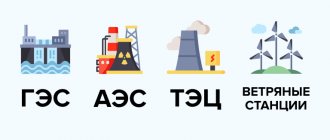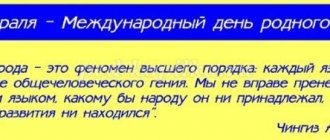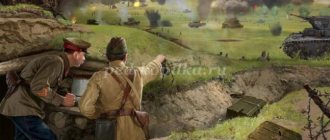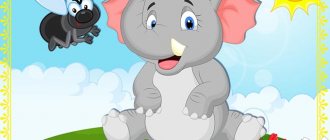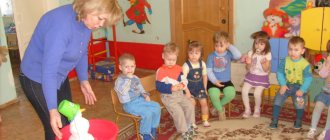Summary of a lesson on cognitive development in the preparatory school group “Red Book”
Summary of a lesson on cognitive development in the preparatory school group “Red Book”
Educational field: Cognitive development
Type of GCD: introduction to the natural world.
Goal: To consolidate the belief about the pricelessness of nature and bring to the conclusion about the need to protect birds.
Tasks:
Educational: to cultivate a sense of responsibility for one’s behavior in the natural world, the skills of caring for animals and plants; evoke an emotional response. Cultivate kindness, responsiveness, and love of nature.
Developmental: instill feelings of empathy for the problems of the surrounding nature; encourage them to be active conservationists; develop an understanding of the importance of the role of animals and plants in human life, develop logical thinking, attention, observation, curiosity; increase children's speech activity, mental activity, and develop the ability to answer questions.
Educational:
Teach rules of behavior in nature; understand the connections that exist in nature, clarify the role of humans in the life of birds; list protected birds listed in the Red Book; enrichment and activation of vocabulary on the topic.
Equipment: multimedia projector, containers for oil and water, fur, brushes, napkin, oilcloth, gel ball, needle, flower.
Progress of direct educational activities.
1. Organizational moment. (in a circle)
All the children gathered in a circle.
I am your friend and you are my friend.
Let's hold hands tightly
And let's smile at each other.
Educator: - I’ll look at your faces, who should I make friends with here?
Educator: Today we will go on an exciting journey into the mysterious world of nature, learn about the existence of an unusual book and what it is needed for.
Please look at the screen. What is this? (children's answers).
-That's right, the Red Book. Who knows what kind of book this is? (children's answers)
— Among the birds, animals, insects, trees and flowers, there are some of which there are very few left. They are called rare or endangered. Why do you think they have become rare? (children's answers)
— Rare animals and plants in our country and in our district are protected by law. But unkind people often break this law. Man is often very cruel to plants and animals. Very often people do not spare them and destroy them for their own purposes. Some suffer because of beautiful fur, others because of tasty meat, and others because people are afraid of them. Gradually, there are fewer and fewer plants and animals left. And then people started thinking about how to stop the disappearance of animals. So we decided to create a Red Book. Why Red and not some other color?
Distance learning for preparatory group children on the lexical topic “The Red Book”
This is what the Red Book of Russia
Regional Red Data Books cover the territory of one region or region A, this is what it looks like
Do you think the beauty of nature
?
Does man always help nature? (
Children's
) .
But we are tightly connected with plants and animals. We destroy the birds - insects will eat all the greens - people will not be able to eat fruits and vegetables. This always happens in nature: one disappeared, another fell ill, and a third died.
complaint book
Listen to the complaints of animals and plants and try to determine who the complaints came from.
Complaint 1:
“Oh, people don’t like me. You see, they don’t like my voice and my eyes, they say I’m not beautiful! They think I bring trouble. And I fly all night, catching mice. And when it gets light, I’ll go to sleep in the hollow.” That is?
This is an owl. The owl is under state protection. One owl destroys 1000 mice over the summer, which are capable of destroying 1 ton of grain.
Complaint 2:
“I know myself that I’m not a beauty, I live in a swamp. I sing songs loudly and swallow mosquitoes. And if I were nearby, many would shy away to the side, or else they would throw a stone or kick me. For what? I am of great benefit." Who is this?
This is a toad. One toad saves an entire garden from caterpillars and worms. If there are cockroaches in your house, get a toad and they will disappear.
Complaint 3
“I lived in the world for sixty years, but last spring a young tourist came up to me and carved the word “Lenya” on my trunk and my juice flowed out. In the summer, a summer resident came up and cut out “Vanya”, now various harmful insects crawl under the bark, and I die.” Who is this?
This is a birch tree. In summer, birch trees save people from the heat and provide very healthy and healing birch sap, which increases the body's resistance to colds, infectious and allergic diseases. And they clean the air.
Complaint 4:
“I am neither alive nor dead. I'm so intimidated - I'm afraid to rustle. They throw whatever they can at me, sticks and stones just whistle. These guys are knocking down acorns. They can't wait until they fall to the ground. I’m covered in scratches and cracks, all my branches were twisted, and my twigs were broken.” Who is this?
This is oak. In nature, wild pigs, deer and even bears feed on acorns. Acorn flour and coffee are also made from acorns. Tree leaves release oxygen and save us from the heat in summer.
In the old days, people wisely used the gifts of nature. They never killed females and babies, released young fish and fish with eggs from nets, and only cut down old and diseased trees. Unfortunately, nowadays people have forgotten about these good traditions of their ancestors. But the remarkable thing is that a person knows how to correct his mistakes. In addition to the Red Book, people came up with nature reserves. What is a reserve? A reserve is a place where nature has the right to live according to its own laws. But a person does not interfere with them; he occasionally comes to this place as a guest. Everything in the reserve is protected: herbs, mushrooms, birds, fish and all living things.
Abstract of GCD for FCCM “Red Book”
author: Muldryakova Daria Sergeevna
teacher of MBDOU No. 36 “Yablonka”
Abstract of GCD for FCCM “Red Book”
Summary of GCD in the senior preschool age group.
Subject:
"Take care of animals".
Target:
formation of the foundations of ecological culture.
Tasks:
Educational:
- introduce children to the Red Book, rare and endangered animals;
- develop the ability to conduct a conversation on a given topic;
Educational:
- develop attention and the ability to draw conclusions;
- develop fine motor skills.
Educational:
- cultivate a humane and responsible attitude towards all living things; interest in nature and problems of its protection; correct behavior in the natural environment.
Vocabulary work:
Red Book, Amur tiger, polar bear, river beaver, snow leopard, emperor penguin, marsupial wolf.
Material:
Interactive whiteboard, presentation about the Red Book, pictures of rare and endangered animals, d/i “Collect a picture”; signs depicting a forest fire, deforestation, a hunter with a gun, factory chimneys, feeding animals, garbage and broken glass, do not pick poisonous mushrooms, pick up trash after yourself, do not catch too many fish
GCD move
-Guys, let's stand in a circle and say hello to each other. Let's give each other smiles
All the children gathered in a circle (stand in a circle)
I'm your friend (hands to chest)
And you are my friend (they extend their hands to each other)
Let's hold hands tightly (hold hands)
And let's smile at each other (smile)
-Guys, let's imagine that you and I came to the cinema, how should we behave?
-(children's answers)
- That's right, you need to sit quietly and not distract anyone. Sit down on the chairs, the session begins.
(children sit on chairs in front of the interactive whiteboard, a presentation about the Red Book is turned on)
-Guys, we just watched an educational film, what was it about?
-(children's answers)
-That's right about the red book! The Red Book writes about rare animals, birds, plants, and insects. The Red Book was created for control and protection.
Did you remember that the pages of the Red Book are multi-colored? This is not for decoration. By the colors of the pages, you can tell what position a particular type of animal is in.
The first pages are red. The red pages contain especially rare and
endangered species.
The snow leopard is a large predator from the cat family. The snow leopard is also called the snow leopard. These animals live in the mountains of Central Asia.
-The next pages in the book are yellow. If a traffic light is yellow, what does it mean?
Children: you can't rush.
Educator: The Yellow Pages remind us that these plants and animals are few and must be saved.
The Amur tiger is the largest cat on the planet, unmatched in strength and power. Only she is not afraid of snow, frost and taiga wilds. But she is afraid of poachers, fires, and deforestation.
White pages - animals are recorded, the number of which has always been small. They live in small areas. For example, a polar bear. The polar bear is the largest species of bear.
The gray pages contain the names of animals that are still little studied. Their habitats are difficult to access or not clearly established. For example, the Emperor Penguin. The emperor penguin is the largest and heaviest.
Next are the green pages of the book. What do you think they mean? Yes, you can be happy for these plants and animals, there are still a lot of them. People came to their aid in time. For example, the River Beaver - The beaver itself is about a meter long, and has a flat tail shaped like an oar. This is one of the largest rodents.
The black pages contain extinct animals that we will never see again. For example, the marsupial wolf is an animal that no one has seen for many, many years.
- Guys, let's be professors for a second and help our animals. Look at the tables there is a task prepared for you, you and I will divide into teams of two and quickly complete the task, Right? (children go to the tables where there are cut-out pictures of animals in envelopes) What a great fellow you are, you quickly completed the task. Who did you get? (children name animals)
- Guys, are you tired? Let's move around a little and relax.
Fizminutka
A bear wanders through the forest, walking from oak to oak. (Waddle)
He finds honey in the hollows and puts it in his mouth. (“get” honey with your hand)
A club-footed sweet tooth licks the paw (imitation of movement)
And the bees swoop in and drive the bear away. (“shoo away” the bees)
And the bees sting the bear: “Don’t eat our honey, thief.” (lightly pinch your nose and cheeks)
A bear wanders along a forest road to his den. (Waddle)
He lies down, falls asleep and remembers the bees. (hands under cheek, tilt head)
-Take your seats. Guys, why do you think animals become rare or disappear altogether?
-(children's answers)
- Let's see if you answered correctly. (the teacher opens the cards prepared in advance on the board one by one and, together with the children, names the reasons for the disappearance of animals)
-Well done! Do you think that if we all follow the rules of behavior in the forest, we will help the animals?
-(children's answers)
- And so that we never forget about rare animals, now you and I will create our own Red Book, which will be in our group. Every time, listening to stories, reading newspapers about rare plants and animals, we will add pictures and illustrations so that each of us remembers the plants and animals on the disturbing pages of the Red Book again and again.
In front of me are cards with animals, and on the board are pages from the Red Book, let's name what color the pages are.
-(children's answers)
-You will go to the board one by one, take a card, say the name of the animal and place it on the desired page.
(Children complete the task, the teacher helps if there is difficulty).
“You guys are great, you completed the task quickly, and I can be sure that you will be real defenders of nature.”
Reflection:
— What did you learn new?
-What was interesting?
-What was difficult?
-What did you like most?
Project in the senior group “Opening the Red Book of Russia”
Objective of the project:
introduce children to the Red Book of Animals of the Russian Federation and species of rare (endangered) animals; with the concepts of “habitat”, “food chain”, with the work of zoos and reserves to preserve rare species of animals; to give an idea that nature is a single living organism in which all animals and plants are important (there are no good or bad ones); to cultivate a caring attitude towards nature: nature is diverse, but fragile and not limitless, it must be protected and preserved.
Lesson No. 1 “Opening the Red Book.”
Objectives: familiarization with the Red Book, the concept of “rare animal”.
View the presentation “Animals from the Red Book”.
During the lesson, the guys and I watched the presentation and had a conversation. The children were surprised at how many animals they know were included in the Red Book. The term “rare animal” was explained. The children were asked a problematic question: why are there fewer animals? (Animals have little food, animals have nowhere to live, animals are hunted). At the end of the lesson, the conclusion was made that rare animals need to be saved.
In the evening, watch the cartoon “The Red Book” (animated series “Smeshariki”).
Lesson No. 2 “Habitat”.
Objectives: familiarization with the concept of “habitat”, what it is; explain why animals live only in certain habitats, why habitats disappear, how people can help animals survive.
View the presentation "Habitat".
During the lesson, while showing the presentation, the term “habitat” (the place where the animal lives, hunts, and breeds) was explained to the children. The habitat may disappear, then the animals have nowhere to live and nothing to eat. Habitats can disappear due to natural disasters (for example, a forest fire) or due to destructive human activities (air and water pollution; deforestation and construction of houses and roads in their place). Conclusion: the habitat of animals must be treated with care: assess the harm and benefits that a change in the habitat can bring.
In the second part of the lesson, children were shown pictures with various habitats: forest, swamp, sea, field, tundra (permafrost), etc. After this, the game “Who lives where?” was played.
Pictures with different animal habitats were displayed on the board, and the child had to “place” the animal from the pictures in its habitat.
Conducting the didactic game “Who Lives Where?” (meadow-butterfly, Arctic - walrus, swamp - heron, forest - badger).
Lesson No. 3 “Food chains”.
Objectives: to introduce children to the concepts of “predatory animal”, “herbivore”, explain the relationship between predatory and herbivorous animals, mutual benefit; explain the concept of “food chain”; During the game, bring the children to the conclusion that if one of the links in the food chain disappears, then the whole chain is destroyed.
View the presentation “Carnivorous and herbivorous animals. Food chains".
While watching the presentation, it was explained to the children that predatory and herbivorous animals can be distinguished by their teeth: a predatory animal has sharp teeth (fangs), since they need to hunt, while herbivores have blunt teeth, they use them to chew grass, bark, and leaves. Herbivores are food for carnivorous animals. But in nature there are no “bad” and “good”, “evil” and “good” animals, they all bring benefits. Herbivores promote plant growth, while carnivores hunt primarily old and weak animals, helping the strong and healthy to survive. Plants, herbivores and carnivorous animals are combined into a food chain: plants are food for herbivores, herbivores are food for predators.
In the second half of the lesson, the game “Make a food chain” was played. Children were given pictures on their tables with paper clips (chain links) attached to them. The children had to determine who was eating what (whom) and connect the chain correctly. After making the chains, the children, at the request of the teacher, covered one of the animal pictures with their hand and explained what would happen if one or another animal disappeared (if there were no mosquitoes, the frogs would starve, etc.). In this way, children were led to the idea that there are no “extra” or “bad” animals in nature. They are all important and they all bring some benefit to each other.
At the end of the lesson, the children were offered models to represent carnivorous (a triangle in a circle - a sharp tooth) and herbivores (a rectangle in a circle - a blunt tooth) animals.
Food chains collected by children.
Lesson No. 4 “How people save rare animals.”
Objective: to give children an idea of working in zoos and reserves to preserve rare species of animals; concepts of “reserve”, “bird ringing”, “animal capture”.
View the presentation “How people save rare animals.”
While watching the presentation, the children were told about the work of people in zoos and nature reserves. The zoo breeds animals in captivity. They can no longer be returned to the wild, but they can survive near people. A reserve is a huge area of wild nature where any human activity to change it is prohibited (deforestation, drainage of swamps, construction of houses, etc.). In nature reserves, scientists study wild animals and help them survive (they count the animals, feed them in winter, and make sure that the animals do not get sick). When there are many animals in the reserve, they are caught and transported to another reserve, where there are few such animals. Scientists ring birds to track where these birds fly in winter and where they bear offspring. Then the children were explained the rules of behavior in the zoo (do not feed the animals, do not knock on the glass, do not make noise) and in the reserve (you cannot tear plants, you must walk along the paths, you must not make noise, etc.).
At the end of the lesson, the children were shown models that will indicate in Our Red Book: “you cannot hunt,” “the animal is protected in the reserve.”
Throughout the project, in the evenings there was a screening of the BBC documentary “Climate Zones of the Earth. Habitat".
The knowledge acquired by children in classes to familiarize themselves with the world around them was supported in classes on productive activities.
Application – “Polar bears on an ice floe”.
Construction – “We are building a zoo.”
Modeling - “My favorite animal from the Red Book.”
The result of the project activity is the creation of the Red Book of Animals for the group.
Goal: to create a manual that children and group teachers could use.
In order for children to be able to “read” the book on their own, a modeling method was used. All models were explained to the children during the entire project in class. For educators, a page with the necessary material has been made about each animal.
Children “read” Our Red Book.
Authors: Botkina Svetlana Sergeevna,
Klyagina Daria Borisovna,
teachers of GBOU secondary school No. 349 in Moscow
(preschool department No. 1205)
The article is published in the author's edition
